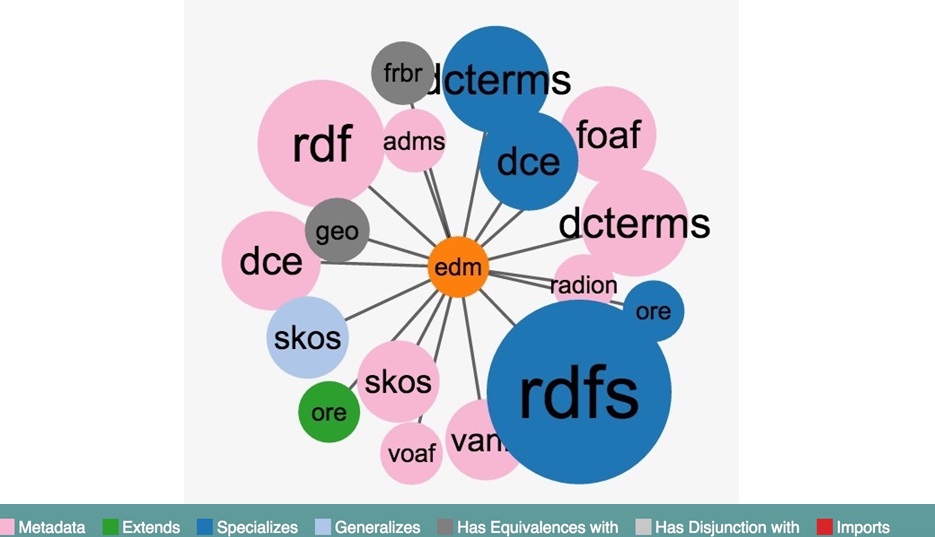The Europeana Data Model: A living model 5 years on

Today we’re publishing a new White Paper on the enhanced Europeana Data Model (EDM). In this blog, we look back at how the EDM first became a reality, and the progress we have made with it as a living model since then.
A couple of weeks ago, the World Wide Web conference took place in Florence. During the conference, speakers and attendees placed great emphasis on "knowledge graphs". Beyond the academic hype, knowledge is now a core element in web technology and businesses. So what’s the connection with Europeana and the cultural sector?
Five years ago, Europeana's very first White Paper, by Prof. Stefan Gradmann, discussed the idea of Europeana as a knowledge graph, formed with metadata on cultural objects augmented with a so-called "semantic layer". The aim then was to position Europeana and its data partners as a source of contextual knowledge that everyone could exploit to access digitised European heritage. To achieve this, the white paper advocated the design of an advanced data model, re-using existing pieces of web technology.
Putting an idea into practice
Europeana has since grown to a collection of over 40 million objects. The richness of its data can still be improved, as raised in recent discussions. However, these reports also show that our Network is increasingly capable of identifying and tackling these issues. Over the last five years we have progressed considerably, and Europeana is already reaping some of the promised benefits of semantic web and linked data technologies.
First and foremost, the Europeana Data Model (EDM) has become a reality we can work with, together with our data partners and data re-users. Today, we’re publishing a new White Paper that outlines the recent progress we have made with our model.
Since its original release, EDM has permeated the entire portfolio of Europeana products: we ingest, store, enrich and exchange data following a richer, more semantic (and more multilingual!) approach. This work continues, for example, as Europeana prepares to handle more data enrichment, including user annotations.
EDM has also been extended to meet the data needs of specific domain aggregators, like Europeana Sounds, and address the requirements of new data services and enrichment in Europeana's main platform. EDM is now used by Europeana and several other cultural aggregators, such as DPLA and DDB. In true linked data fashion, EDM "profiles" can be developed without Europeana having to update the core model anymore. Exploiting the data expressed with these profiles across different systems still requires work. But it is no longer impossible to realise the vision where the design of data models is decentralised and tailored to specific applications, while the data created and exchanged with them still forms together a vast, semantically interoperable knowledge environment.

Re-use of different vocabularies in EDM from Linked Open Vocabularies
A collaborative approach
This is not a "one leader, many followers" movement. Several months ago we released a blog post illustrating how data partners can better represent their existing metadata using links to established thesauri, which makes it more amenable to semantic and multilingual services. This greatly complements Europeana's own centralised semantic enrichment efforts. The same approach benefits our data modelling effort. EDM would not exist without the contributions of our data and academic partners!
To succeed in all this, Europeana must do a lot of what we call "R&D coordination". We shared good news on technological advances and encouraged their use. We have created a Linked Data pilot at data.europeana.eu (soon to be updated!), which was the very first application of EDM. We have gathered case studies. We even have released a fairly popular video that explains what Linked Data technology is and how it can benefit cultural organizations.
We also participate in academic and practitioners' conferences, often having an active role, presenting and/or participating in their organisation or review committees: LODLAM, TPDL, DC, SWIB, ESWC, etc. This ensures that we can feed our community's work with the freshest R&D results. It also provides a great opportunity to disseminate innovations and share the requirements from the Europeana Network within the wider community of researchers and practitioners. We also engage in collaborative, international prospective workshops, like those organized by the Mellon foundation, the LD4L project, or NISO.
However these venues form a fairly scattered landscape. To share and discuss relevant developments more easily in the Europeana Network, we have created a technology-focused community: EuropeanaTech. We've backed it up with a conference, the two first editions of which have been great successes with over 200 participants. We're also exploring EuropeanaTech Insight, a medium to showcase our partners' work and various publications as progress for the entire Europeana community. The second issue of this publication focused precisely on data modelling.
All of this is required to make the Europeana Network deliver on its promise to be a key cultural innovator, in line with the Europeana Strategy 2015-2020. The EDM White Paper we've just published shows that for data modelling, we're making clear progress towards this goal. Concrete work has been done which not only realises our vision, but builds upon it too.
To celebrate this, we are looking into organising a special workshop on EDM just before or during the next Europeana General Assembly in Amsterdam. If you are interested, please contact us. We're looking forward to getting together with all the data experts in our network to celebrate and discuss further directions for the data work in our community!
